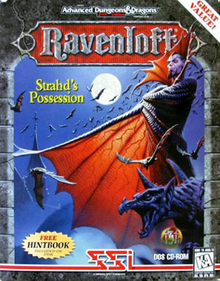Ravenloft: Strahd's Possession
 Cover art | |
| Developer(s) | DreamForge Intertainment |
|---|---|
| Publisher(s) | Strategic Simulations, Inc. |
| Platform(s) | DOS |
| Genre(s) | Role-playing video game |
| Mode(s) | Single-player |
Ravenloft: Strahd's Possession is a 1994 fantasy role-playing video game developed by DreamForge Intertainment for Strategic Simulations, Inc. for DOS. Ravenloft: Stone Prophet is a sequel to this game.
Plot
The game is based on the Ravenloft campaign setting for the Dungeons & Dragons fantasy role-playing game. The game is set in the domain of Barovia.
The player characters are servants of the Lord Dhelt, leader of the land of Elturel. After an assassin assaults the Lord and steals his Holy Symbol of Helm, the PCs are sent in pursuit of the thief. Instead of catching the criminals, however, they somehow manage to transport the entire party to the mist-shrouded land of Barovia, ruled over by the vampire Count, Strahd von Zarovich.
As Barovia is surrounded by an impenetrable poison mist, the PCs have no choice but to explore the dark land of Barovia, which is crawling with undead and many more nasty things. Strahd, himself, seems interested in the characters' quest for the stolen amulet and invites the party to his castle. The characters' quest is to survive this hostile land, long enough to unravel the mystery of the stolen amulet and somehow arrange safe passage out of Barovia.
Gameplay
The game used 3D computer graphics and used a game engine identical to the later SSI title Menzoberranzan. Generally, the keyboard or mouse-driven directional arrows were used to move around or change perspective. As an early 3D game engine, it moved slowly and could appear cumbersome. However, there was an omnipresent map in the top corner which helped gamers from becoming too disoriented by the slow and cluttered progress of the game.
The fighting system involved using the mouse to pinpoint enemies and click to attack. At which point, party members would take turns attacking. This unique combat system presented some logistical problems for gamers, and seemed to involve quite a learning curve.
A review in Game Bytes Magazine said: "Characters with weapons in hand will use them one by one [...] However, since the characters have a go one at a time from left to right, and they take a varying amount of time to ready their weapon again after using it, depending on their dexterity, one often finds that characters who are ready to use their weapons cannot do so because the computer is waiting for the character whose turn it is to ready and use his weapons before going to the next one. Hence, one may be anxiously clicking away but no one is using their weapons."[1]
Sound
Voice acting was used in some versions of the game and the Eastern European accent of the central characters did much to improve its believability. The acting was generally well received. But, in the case of Strahd, as Game Bytes Magazine stated "The attempt to make him sound suave yet menacing (which is as it should be) didn't quite come off."[1]
The music of Strahd's Possession was highly atmospheric and was critically acknowledged as a vast improvement of SSI's previous offerings. Game Bytes Magazine said "The music superbly brings out the mood and atmosphere, and is reminiscent of those found in gothic horror movies, with the organ being the central instrument."[1]
Publication history
This game was later included in the 1996 compilation set, the AD&D Masterpiece Collection.[2] On October 27, 2015, the game was re-released on GOG.com, bundled with the sequel.[3]
Reception
According to GameSpy, "Ravenloft: Strahd's Possession was a welcome return to form for SSI".[4]
References
- ^ a b c Sir Launcelot du Lake (1994), "AD&D RAVENLOFT: STRAHD'S POSSESSION CD from SSI", Game Bytes Magazine, vol. 21
- ^ Butcher, Andy (January 1996). "Games Reviews". Arcane (2). Future Publishing: 80.
- ^ Release: Dungeons & Dragons: Ravenloft, Dark Sun, Krynn Series
- ^ Rausch, Allen (2004-08-17). "A History of D&D Video Games - Part III". Game Spy. Retrieved November 17, 2012.
